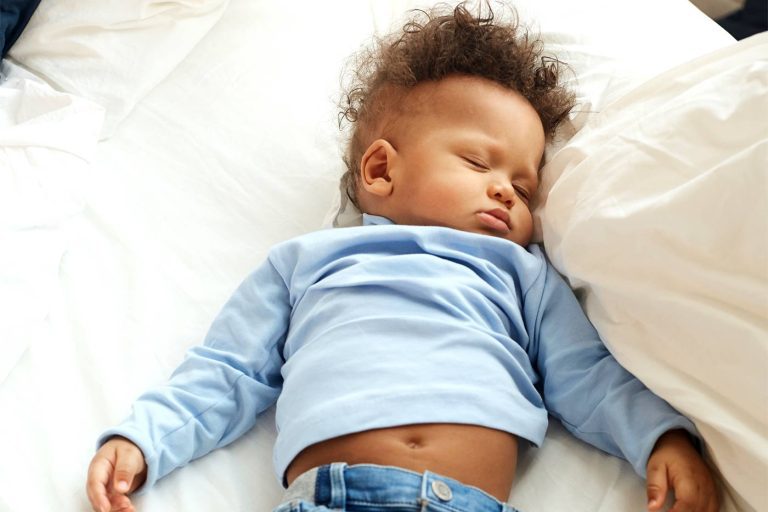
Sleep Solutions for Toddlers: Overcoming the 2-Year-Old Sleep Regression for Your Baby
- Created:
24. 8. 2023 - Updated:
7. 2. 2024
To begin with:
Sleep regression is a common phenomenon experienced by 2-year-olds, and it’s majorly characterized by disrupted sleep patterns and increased fussiness.
This temporary regression can be attributed to various factors, including developmental milestones, changes in routines, and separation anxiety.
Note:
Understanding the causes and symptoms of sleep regression is essential for parents to tackle this phase and restore their child’s sleep habits.
Fortunately:
We’ll be discussing all you need to know about this regression and how best it can be managed.
Let’s jump right in!
The 2-Year-Old Sleep Regression: Factors and Solutions
Sleep regression in 2-year-olds is mostly caused by factors like developmental milestones and separation anxiety. Luckily, they can be managed by establishing a consistent bedtime routine, creating a soothing sleep environment, and addressing separation anxiety. It’s important that parents seek professional help if sleep regression persists or causes significant distress.
As we progress, we’ll consider the factors that cause the 2-year-old sleep regression in detail and show you easy steps to overcome them.
Keep reading!
What Causes Sleep Regression in 2-Year-Olds?
Get this:
Sleep regression in 2-year-olds is a natural phase in the toddler’s growth process characterized by disrupted sleep routines and increased nighttime wakefulness.
It can be attributed to a combination of factors, including developmental milestones, changes in routines, and separation anxiety.
Now:
To effectively navigate this challenging phase, it is crucial to understand the underlying causes of sleep regression.
Fortunately:
In this section, we will take an in-depth look at the common causes that contribute to sleep regression in 2-year-olds.
By understanding these causes, parents can develop suitable approaches to assist their babies in achieving peaceful sleep.
Ready?
1. Developmental Milestones
Fact:
Developmental milestones are one of the major culprits behind sleep regression in 2-year-olds. At this age, your toddler is rapidly acquiring new skills and abilities, such as walking, talking, and general motor skills.
Now:
While these milestones are intriguing and crucial for their growth, they also create an overwhelming sense of excitement and cognitive stimulation.
To support:
Unicef suggests that these cognitive and physical milestones make it more difficult for your toddler to fall asleep.
2. Changes in Routine
Generally:
Toddlers thrive when they have a regular schedule and know what to expect. They rely on familiar patterns to feel secure and comforted.
So:
Introducing alterations to their daily routine can disrupt their sense of stability and trigger feelings of anxiety.
For example:
Transitioning from a crib to a bed, starting preschool, potty training, or experiencing changes in caregivers.
These changes may cause anxiety and make it harder for them to relax and fall asleep at night.
3. Separation Anxiety
Typically:
Separation anxiety peaks around 8-10 months of age, but it can resurface or intensify around the age of two. It is usually a sign of how well they have bonded with their parents or primary caregiver.
At this stage, toddlers form strong emotional attachments to their parents or primary caregivers; any separation from them can trigger anxiety and distress.
In that case:
Your baby will find it difficult to settle down and sleep since their primary source of safety and comfort seems nowhere in sight.
4. Cognitive and Sensory Awareness
Get this:
According to the Centres for Disease Control and Prevention (CDC), as children become more cognitively aware, they develop a wider imagination and are more in tune with their surroundings.
Ideally:
They begin to develop a heightened sense of fear and become easily stimulated by noises, lights, or even their own thoughts.
Sadly:
This increased awareness can make it challenging for your toddler to fall asleep peacefully, causing sleep regression.
But:
This regression may not affect all 2-year-olds in the same way. Each child is unique and may respond differently to changes and milestones.
Still, it is common for toddlers to experience some degree of sleep regression during this stage of development.
Symptoms of Sleep Regression in 2-Year-Olds
Note that:
Sleep regression in 2-year-olds is often characterized by a range of noticeable symptoms that can disrupt their sleep patterns and affect their overall behavior.
By getting familiar with these symptoms, parents can identify and address the challenges associated with sleep regression in their child. Let’s discuss some of them:
1. Difficulty in Falling Asleep
Clearly:
One of the primary symptoms of sleep regression is an increased difficulty in falling asleep at bedtime. Toddlers become more resistant to bedtime routines or struggle to settle down.
Furthermore:
They may exhibit restlessness, demand extra attention, or attempt to delay their bedtime with persistent pleas for another story or extended screen time.
2. Increased Fussiness
Generally:
Sleep regression can also manifest as increased fussiness and irritability during the day. You’ll realize the child becomes more temperamental and irritable.
Also, the lack of quality sleep makes it hard for them to regulate their emotions.
Consequently:
They may exhibit more tantrums, clinginess, or difficulty engaging in activities that require focus and attention.
3. Change in Sleep Routine
Now:
Another symptom commonly associated with sleep regression is a change in your toddler’s sleep routine. They start to wake up earlier than their normal schedule or find it difficult to sleep at night.
They may also wake up multiple times throughout the night or too early in the morning, causing disruptions in both the child’s and parents’ sleep.
Understandably:
This can be challenging for parents that have established routines based on the child’s previous sleep routine.

How to Manage Sleep Regression in 2-Year-Olds
First off:
Managing sleep regression in 2-year-olds can be a challenging task. These regressions can turn peaceful nights into chaotic battles, leaving parents exhausted and children restless.
Luckily:
We have compiled some effective strategies to help you navigate this phase and establish healthy sleep habits for your toddler.
Consider the following tips for managing sleep regression in 2-year-olds:
1. Maintain a Consistent Bedtime Routine
Ideally:
A consistent bedtime routine offers your child a sense of familiarity and comfort. Consistency is key; it helps create a soothing environment that promotes relaxation.
So:
Follow an established order of activities, such as taking a warm bath, reading bedtime stories, and cuddling. This will help signal to your baby that it’s time to unwind and prepare to sleep.
Additionally:
Reinforcing a regular sleep schedule allows your child to become accustomed to a consistent sleep pattern. Thus making it easier for them to fall asleep and stay asleep throughout the night.
Pro Tip:
Tracking your baby’s sleep helps you identify patterns and gain a better understanding of their sleep habits. This knowledge makes it easier to address any sleep challenges that may arise, including sleep regressions.
2. Create a Relaxing Sleep Environment
Basically:
Maintaining a sleep-friendly environment can help reduce sleep regressions. A peaceful sleep environment reduces external stimuli that may disrupt sleep and helps the child feel more comfortable and secure.
But how do you achieve this?
- Keep your toddler’s room quiet, cool, and dimly lit. You can consider using blackout curtains to minimize external light.
- Ensure you use a comfortable mattress and tight bedding.
- Use white noise machines or soothing music to mask any disruptive sounds. White noise simulates the sounds of the womb and makes them feel safe and at ease, inducing drowsiness.
- Introduce a stuffed animal or blanket that emanates safety and comfort.
By providing a conducive environment, the child is more likely to fall asleep easily, allowing you to manage sleep regressions.
3. Gently Tackle Separation Anxiety
Fact is:
Sleep regression often goes hand in hand with separation anxiety. Separation anxiety can make it difficult for a child to feel secure and comfortable sleeping alone.
This leads to your baby fighting sleep at bedtime and waking up frequently during the night.
Therefore:
Addressing separation anxiety in a gentle and supportive manner can help overcome sleep regressions.
You can do this by:
Gradually increasing separation during daytime activities and engaging in soothing bedtime routines, such as reading a story or cuddling.
The National Health Service (NHS) advises to ensure you have a relaxing, consistent bedtime routine that you follow every night around the same time.
In addition:
The use of transitional objects, like stuffed animals, can help your toddler develop a sense of safety and confidence.
Leaving your baby with another caregiver also helps them learn to cope without you. Once they’re used to being around other people in your absence, they develop a sense of independence and self-confidence.
This newfound confidence can extend to bedtime routines, making it easier for them to fall asleep and handle brief separations.
Note:
Parents must address separation anxiety with patience, understanding, and consistent reassurance. That way, they can help the child gradually overcome their fears and establish healthy sleep patterns.
4. Encourage Healthy Sleep Habits
Now:
Establishing healthy sleep habits can help manage sleep regressions by regulating your child’s bedtime routine and overall sleep-wake patterns.
In addition to maintaining a consistent bedtime routine, you should also limit screen time, particularly close to bedtime. Electronic devices emit blue light that can interfere with the sleep-inducing hormone melatonin.
Then:
Avoid overstimulation close to bedtime and introduce self-soothing techniques to your toddler. Also, encouraging regular physical activity during the day helps them expend excess energy and promote healthy sleep hygiene.
Essentially, with healthy sleep habits, your child is less likely to experience sleep regressions.
5. Be Patient and Understanding
Remember:
Sleep regression is a normal part of a child’s development. It is temporal and will eventually fade as your child adapts to new skills and milestones.
Truth is:
If you approach sleep regressions with patience and a positive mindset, you will be able to tackle the challenges it comes with.
Patience allows for a more empathetic and gentle approach to addressing the child’s sleep needs. The positive atmosphere contributes to a calmer bedtime routine for both the child and the parents or caregivers.
When to Seek Help for Sleep Regression in 2-Year-Olds
As we mentioned earlier:
Sleep regressions in 2-year-olds are a normal part of their development and gradually disappear within a few weeks.
However:
There are instances when seeking help for sleep regression becomes necessary. Let’s take a look at them:
1. Significant Distress
It’s no news that sleep regressions can be a very challenging phase. Nevertheless, there are some significant markers that signal the need to seek out professional help for your toddler.
For example:
Excessive crying, extreme difficulty falling or staying asleep, and unusual sleeping behavior.
Also, sleep deprivation can significantly influence the mental health of both the toddler and the parents.
Thus:
If you have increased stress levels or difficulties in managing daily activities due to a lack of sleep, it’s reasonable to seek assistance.
2. Prolonged Duration
Ideally:
Sleep regressions are temporary, lasting a few weeks to a month.
So:
If the sleep regression is extended and shows no signs of improvement, it is advisable to consult a healthcare professional for guidance.
Note:
When considering seeking help for sleep regression in a 2-year-old, it is best to consult with a pediatrician or a sleep specialist.
They can evaluate your child’s overall health, assess any underlying factors contributing to the sleep regression, and provide guidance based on individual circumstances.
Final Tip: Annie Baby Monitor – Your Baby Sleep Regression Solution Helper
If you’re dealing with the 2-year-old sleep regression and it’s getting tough, let Annie Baby Monitor help you out.
You can use its advanced features – baby tracker and sleep history – to keep an eye on your toddler’s sleep patterns and see how they’re changing. That way, you can adjust the sleep routine and give the little better sleep.
Say goodbye to sleep regression and embrace the power of Annie Baby Monitor.

Conclusion
To sum up:
Sleep regression in 2-year-olds can occur due to various factors, such as developmental milestones, changes in sleep routines, and separation anxiety. These factors can disrupt a child’s sleep patterns and lead to difficulties falling asleep.
However:
In order to properly manage sleep regressions, parents have to be familiar with the symptoms to look out for. Some of these include increased fussiness, disrupted sleep routines, and difficulty falling asleep.
The big question is, how do I manage this regression?
It’s quite simple!
- Maintain a consistent bedtime routine.
- Create a relaxing sleep environment.
- Encourage healthy sleep habits.
- Be patient and understanding.
Now:
If you notice significant distress in your baby or the regressions last longer than a few weeks, you should seek professional help.
Finally:
Let us know if this article has helped you understand how sleep regression works in 2-year-olds. Remember to share any additional tips you have in the comment section below!
FAQ: 2-Year-Old Sleep Regression
The 2-year-old sleep regression can be attributed to various factors—developmental milestones, separation anxiety, and increased motor independence. These factors collectively contribute to disrupted sleep patterns and sleep regressions.
To support your toddler during the 2-year-old sleep regression, it’s crucial to actively establish and maintain a consistent bedtime routine. This helps signal your baby when it’s time to relax and sleep. Additionally, creating a soothing sleep environment with dim lighting, white noises, and a comfortable bed can further promote healthy sleep habits.
The 2-year-old sleep regression typically lasts for a few weeks to a couple of months, but the duration may vary for each child. With consistent support and appropriate sleep strategies, most toddlers gradually return to their normal sleep patterns.






